Gerbase for me was a little white letter on a black background from a valve monitor, which would appear, if I was lucky and he was doing the same thing, when typing the command F, from Finger, in the vortex of Ufrgs, the first internet provider of the city of Porto Alegre. We belonged to a group, decades before Face, called Poanet, founded by Jacques Brancher, an agglutinator of doctors, who lived abroad, but wanted to stay connected with their land, like Gerbase who lived in the beautiful city of Geneva and worked, and still works, at the WHO, at the world health organization.
That he had the same “cross-eyed look” as me when observing the world, I learned many years later, almost recently, that he had an artist’s eye and hands when observing and interpreting the world of the Alps, coming from Porto Alegre, as I did Porto Cheerful, coming from the Alps.
affinities. Friendship. Many things in common when traveling, seeing people, interfering with people from another culture, interpreting behaviour, seeing landscapes, mountains and plains, rivers and lakes, the sea, churches and ruins, buildings to live in, buildings showing art.
From there to here, from here to there. Crossed eyes and holding hands.
Happy first exhibition, Gerbase.
– Maria Tomaselli

Gravuras de Antonio Gerbase
Espaço Cultural 512,
Porto Alegre, Brazil, 10th of May to 6th of June 2016.
He came back from a kind of paradise, paradise on the highs, distant in time, distant in space. Showing a genuine and strong interest in the visual arts, I took him to meet my master engravers. Rua da Praia, Museum of Work. Irreplaceable Temple of Engraving, the right address to find them.
First the stone, closest to the true design. Master Paulo Chimendes. A brief history of the origin of Lithography, the procedures, the possibilities, the different techniques were being told… and suddenly the astonishment. Almost a scare. Evidence of a print was already resting in the dryer.
Wood. A second master, Gustavo Freitas, was introduced… and suddenly, amazement again. Several woodcuts, few strokes, simple, elegant, formed beautiful landscapes of the Swiss Alps.
Metal. The third master. Marcelo Lunardi. Enchanting with acids and copper plates, ink water or strong water, once again, now without fear, I saw him throw himself to work with wonderful courage. Without fear of making mistakes, he tackled the three subjects with unusual talent and naturalness. And it is, with the complicity of these masters, that my friend and colleague, A.G., presents for the first time the successful result of these experiments.
– Paul Olszewski
He was born on the plain, but in order not to detract from the hills of Porto Alegre or the naps of the Pampa gaucho, let’s admit that he had already felt in his feet and calves the effort made to overcome a steep climb, before living in Switzerland.
Climbing a mountain in the Swiss Alps is like redoing it with all the senses, not just with the eyes, the valleys, the curves, the folds, the niches, the cliffs, the abysses, the masses, the levels, the planes, the lines surfaces and depths. It is the approach to an object far beyond the dimension of the human body, but within its reach, if it respects its particularities, those of its body and those of the mountain, which is inserted in an atmosphere all its own, unknown to a resident of a city. It changes constantly, from mild to dangerous, from bright and sunny to funereal and deadly, shrouded in mist and snow, rain and clouds, or shining in the sun. Man approaches or moves away, aware of his fragility in the face of nature.
Antônio Gerbase masterfully captured this mountain life in his watercolours, oils and woodcuts. He studied the geometry of the planes, their architecture, the colours, the mountains and his colours.
Because the majesty of a mountain, its inexhaustible volume with all its folds and nuances of colour, makes the soul vibrate. As we know from Mont Sainte-Victoire, one hundred and fifteen years ago.
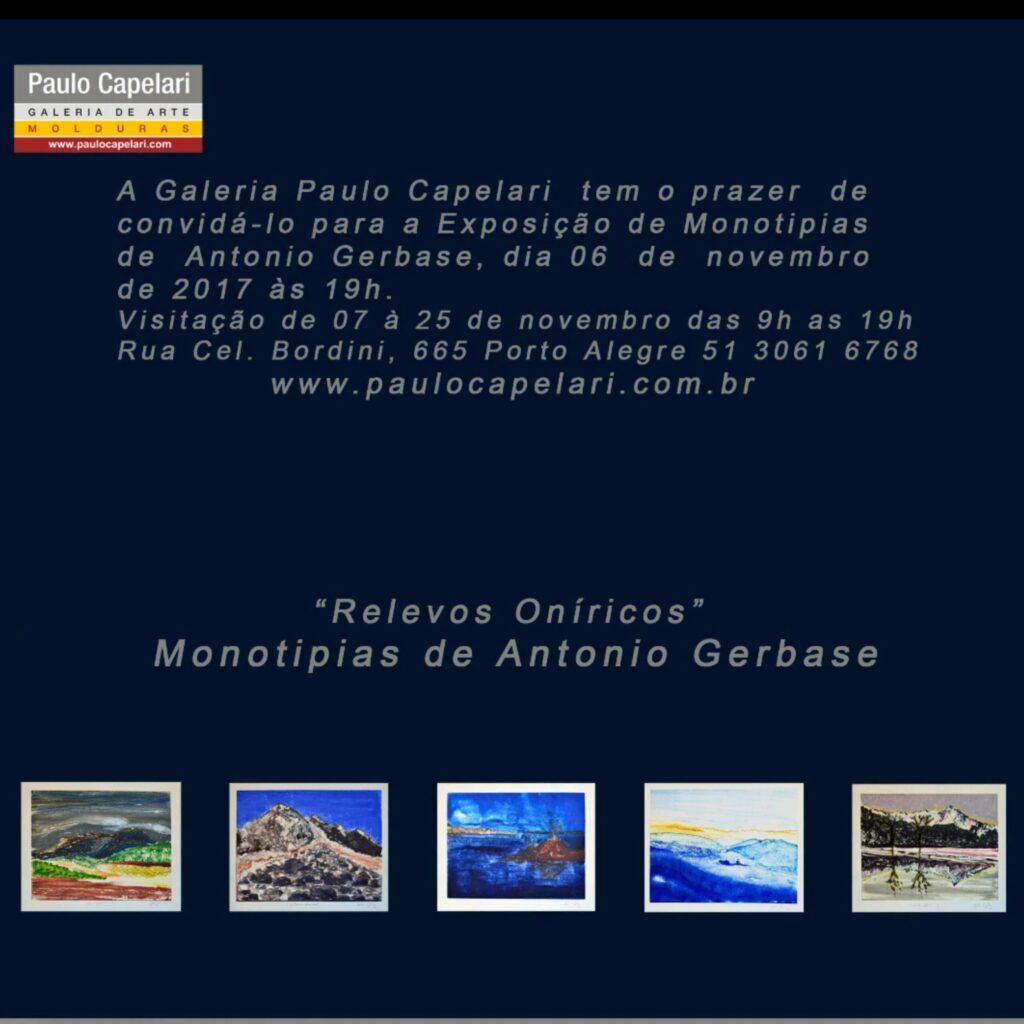
Individual exhibition of monotypes by Antonio Gerbase.
Galeria de Arte Paulo Capelari,
Porto Alegre, Brazil, 6th to 24th of November 2017.
“Relevos Oníricos” gives the title to the exhibition that the plastic artist Antônio Gerbase opens on November 6th, at the Paulo Capelari Art Gallery, in Porto Alegre. The individual brings together 21 pieces in the monotype technique and four woodcuts, in a total of 25 works of medium and large formats, whose predominant theme is the mountains. Paulo Borgato Olszewski is the curator of the show, which will remain on display until November 24th.
The current exhibition by Antônio Gerbase is the result of an artistic process that started about 10 years ago and that in the last five has intensified. Gerbase worked for many years as a doctor at the World Health Organization (WHO) in the area of AIDS and STDs. Outside Brazil since 1991, he has lived in Geneva since 1994, having developed a close connection with the Alps, so present in Switzerland and neighbouring France and Italy. He currently divides his time between international public health work, his chalet in the Alps near Geneva and in Porto Alegre. The trajectory of the global public health professional can be crossed with their production as an artist, insofar as the internal and external experiences of the citizen of the world offer imagery (and aesthetic) substance to the sensitivity of the engraver and painter. That’s why, in his various incursions around the world, as a current consultant for the WHO, the artist Gerbase does not dispense with his kit of pencils, brushes, paints, watercolours and gouaches.
Antônio Gerbase learned from keen observation, from intense and frequent visits to museums around the world, from his collecting spirit, from his interest in art history and from the dialogue with other artists in his frequent wanderings. He began with intense individual and solitary practice of designing and reinventing his surroundings, whether the nature that surrounds him or the works of three artists from the turn of the 19th to the 20th century, whom he admires: Hodler, Valoton and Munch. The objective of reaching the essential, expressiveness and irony is the difficult task that he proposes to develop. He tries, not without suffering, to project what he has inside himself and produce something relevant to the people around him. And for that your current interactions with your current mentors are critical.
With more time in Porto Alegre, since 2014, he received (and receives) regular technical training from a group of recognized plastic artists. Gustavo Freitas (woodcut), Paulo Chimendes (lithography) Maria Tomaselli and Paulo Borgato Olszewski (painting) and Marcelo Lunardi (metal engraving), with whom he developed the monotypes for this exhibition. The meeting place is, most of the time, the Museu do Trabalho, a special and stimulating place where he prints his production.
In the 25 pieces on display, with their dreamlike reliefs, colour intervenes at every moment, in a luminous way, revealing the many contrasts of the landscape and the artist’s gaze. “This mountain life, Antônio Gerbase masterfully captured in his watercolours, oils and woodcuts. He studied the geometry of the planes, their architecture, the colours of the mountains and his colours. Because the majesty of a mountain, its inexhaustible volume with all its folds and nuances of colour makes the soul vibrate”, says plastic artist Maria Tomaselli. Psychoanalyst Aldo Luiz Duarte also commented on the artist’s work: “Gerbase’s art reflects the mind more than the eye, which results in the multiplication of one work in many others, unique, depending on each observer. What more can you expect from an artist?”.
Monotype is a printing technique that consists of reproducing a design or color patch in a single proof. It is a plate on which an image is executed with the appropriate ink. This image is printed, making it the only copy, and it is impossible to obtain an identical copy again. In this way, the monotype is situated between the graphic areas and drawing (or painting).
According to Luise Weiss, “the monotype, therefore, constitutes a hybrid process, between painting, drawing and engraving. It comes close to the gesture of painting, the inkblot, or the trace, the line; at the same time, it has its own engraving characteristics, such as image inversion. Although the name itself clarifies, mono (single) and type (print), that is, that it is obtained from a single proof, in some cases there is the possibility of obtaining more than one copy, evidently increasingly tenuous, clearer. , remaining only a “ghost”/trace of the image”.
The proposed exhibition is the result of an artistic process that began about 10 years ago and has intensified in the last five years.
Antonio Gerbase worked for many years as a doctor at the World Health Organization (WHO) in the field of AIDS, living in Geneva since 1994, having developed a close connection with the mountains, so present in Switzerland. Self-taught, he has been following regular technical training in engraving since 2014 (monotypes, wood, metal and lithography).
In the works on display, with their dreamy reliefs, colour intervenes at every moment, in a luminous way, revealing the multiple contrasts of the landscape and the artist’s gaze. “This view of the mountains, Antonio Gerbase masterfully captured in his monotypes and engravings. He studied the geometry of the planes, their architecture, the colours of the mountains and his favourite colours. Because the majesty of a mountain, its inexhaustible volume with all its folds and shades of colour vibrates the soul”, says Austrian artist Maria Tomaselli in a recent exhibition.
My father was a doctor, my mother a housewife. They had two daughters, both doctors, and four sons: two engineers, a doctor, and myself, the closest thing to an artist to come out of this respectable offspring. What happened with me? Any unexpected mutations in my DNA? It’s difficult to talk about environment and education, since the six sons and daughters followed very similar trajectories in childhood and adolescence. But they didn’t read the exact same books, or listen to the same records, or go to the same dances. And, as popular wisdom says, it’s the balls that spoil people.
Most likely it was a little bit of everything. Some powerful event from my past—reading Monteiro Lobato’s A Chave do Size, dancing to a Chuck Berry compact, or watching The Nutty Professor paying more attention to Stella Stevens than Jerry Lewis—interacted with the genetic mechanisms that made my personality, and the result is this “I” that I carry today, for better or for worse. Ready! I just found a scientific explanation for my artistic bent.
But the reverse path is also common. My sister Maria, a doctor and scientist, makes beautiful videos of her travels. My brother Zeca, a mechanical engineer, is an incredible photographer. My brother Luiz, an electronics engineer, is now a drone pilot and tells stories using high technology. My sister Andréa, a dermatologist, is an antiques collector. To top it off, my brother Antonio, a doctor specializing in public health, starts his show “Relevos Oníricos – Monotipias” on the 6th, at 19:00, at the Paulo Capelari Art Gallery (Rua Cel. Bordini, 665). I bet Dr. José and Dona Léa never considered putting so many artists in the world.
Physicist David Bohm explains that both the artist and the scientist need to “discover and create something whole, beautiful and harmonious. Deep down, it’s what a large number of people in all walks of life are looking for when trying to escape the monotonous daily grind.” Art and science, then, are two sisters busy with the same task: replacing boredom with creation. And we, Gerbases, are busy too. At least until it’s time for the next dance.
Antonio Gerbase é nascido em 1951, em Porto Alegre. Reservado, despretensioso, mas em plena efervescência artística, Antonio Gerbase, divide seus dias entre Porto Alegre e Genebra, além de viajar por vários continentes por sua atividade como consultor em Saúde Pública Internacional. As paisagens desses lugares, sensações das cidades, pessoas e animais estão presentes na obra de Gerbase, dedicado a aquarelas, xilo, lito, gravura em metal, Ipad Art assim como fotografia. O artista tem obras vendidas na Suíça, França, Itália, Noruega e Brasil.
A importante trajetória de Gerbase na medicina iniciou em Porto Alegre, no ano de 1974. Também trabalhou com o Ministério da Saúde do Brasil e Organização Pan-americana da Saúde até 1990. Entre 1991 e 1993 foi pos graduando da Escola de Saúde Pública da Johns Hopkins University em de Baltimore, nos Estados Unidos. De 1994 a 2013 foi medico da Organização Mundial da Saúde, em Genebra. Desde 2013, é consultor em Saúde Pública Internacional.
Quando perguntado em que momento a medicina e a saúde publica se assemelham à arte, Antonio Gerbase responde: “A criatividade e novas abordagens são fundamentais para lidar com uma situação especifica no contexto da evidência científica. O modo de fazer, o modo de convencer , um enfoque “esteticamente harmônico” que assegure uma aliança como o paciente ou com responsáveis pela saúde publica, exige mais do que evidência científica, sem dela prescindir”, explica o médico.
Por outro lado, prossegue Antonio Gerbase: “A alternância entre Arte e Saúde Publica tem um efeito de “repouso no trabalho”, pois as habilidades exigidas, o processo e o produto final são diversos. Ao começar novo projeto em uma, tendo se exaurido no outra, o sentimento é de liberdade e entusiasmo renovado seja para iniciar uma gravura de uma paisagem desértica, seja para implementar pesquisa de novos testes diagnósticos para ISTs.
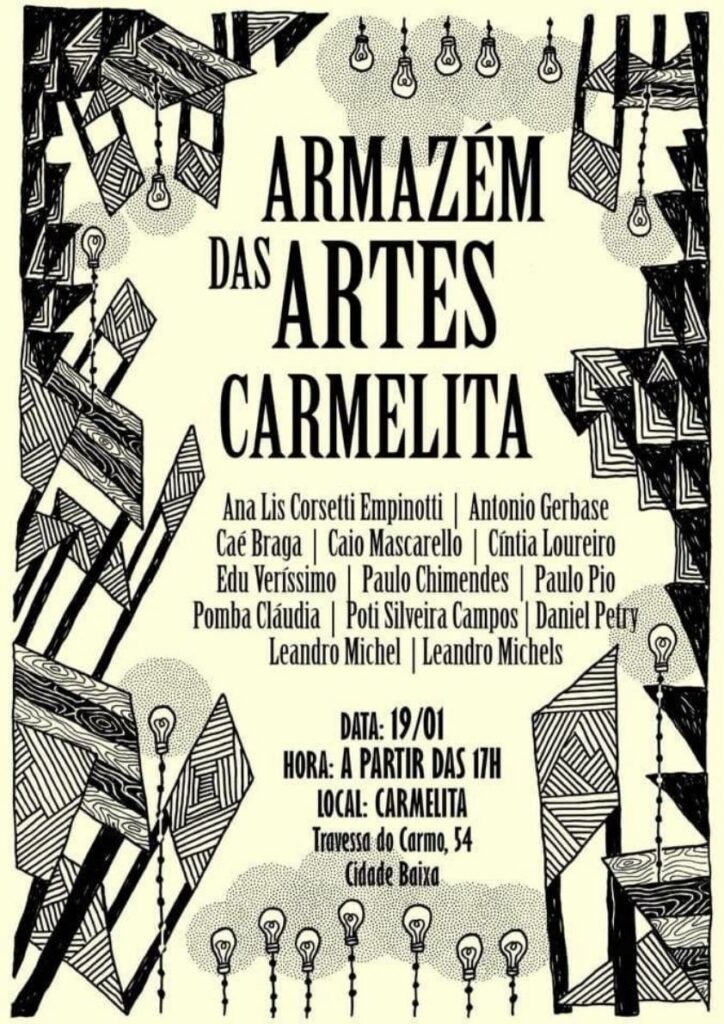

Exposição – Armazém das Artes Carmelita
Porto Alegre, Brasil, 19 de janeiro 2017
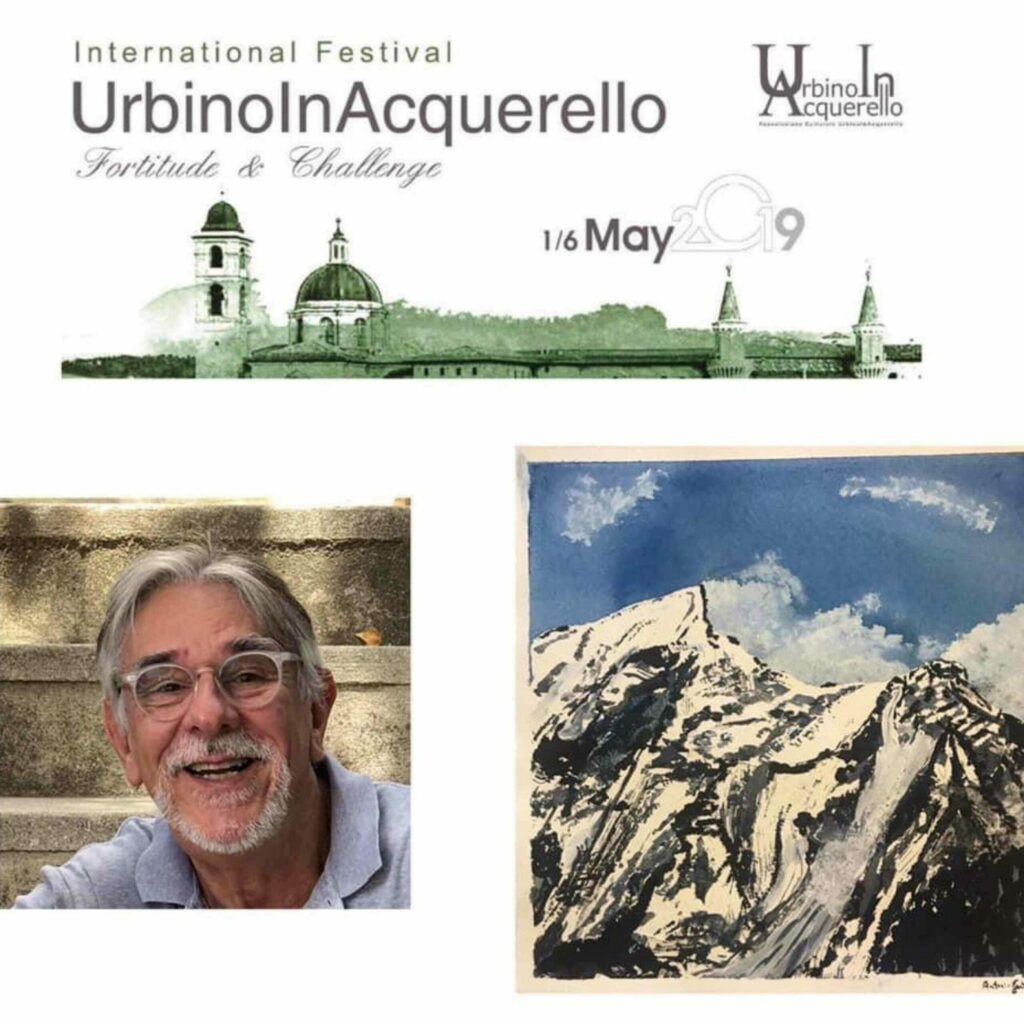
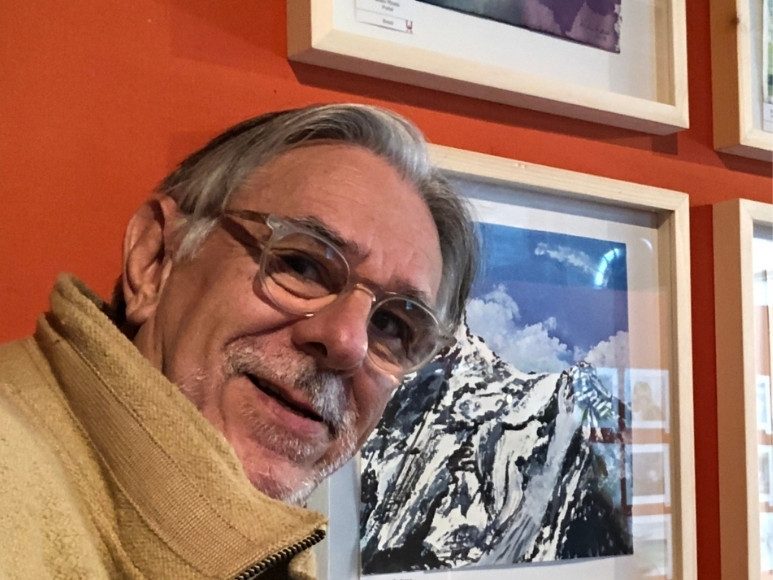
Urbino in Acquarello, Fortitude and Challenge
1 to 5 of May 2019, Urbino, Italy
The proposed exhibition is the result of an artistic process that began about 10 years ago and has intensified in the last five years. Antonio Gerbase participated in numerous individual and group exhibitions in Switzerland, Brazil and Italy.
Antonio Gerbase worked for many years as a physician for the World Health Organization (WHO) in the field of AIDS. He has lived in Geneva since 1994, having developed a close connection with the Alpine mountains and countryside in Geneva.
In the works on display, most of the landscapes, technique and language were adapted to the artist’s sources of inspiration and expression needs.
He is interested in placing art in places where it can be seen by a wide range of the population, stimulating the gaze and at the same time making the exhibition a place for dialogue between all interested parties.
Oneiric Reliefs – Mountain prints, monotypes, wood engravings,
Meinier, Swiss, May 2019
This exhibition includes engravings and photographs taken over the last five years.
There are colours that were added “a posteriori”, not very common in prints until some time ago. There is a certain intellectual fear of colour. The same as when serious film was black and white. That the content engraving was black, period. Fear of being popular, fear of the taste of the poor (“the luxury of the poor is colour”, said Aldemir Martins).
Be that as it may, the colours are influenced by artist friends (Paulo Borgato, Claudia Sperb, Maria Tomaselli), by local technical limitations of introducing them already in print, by the desire to put them and because many like it.
The photographs, influence the look of the engravings and influenced by them are for me, usual companions. In this way they are together, mirroring each other here as well. The mirror appeared because in the room of the “largest smallest gallery in Porto Alegre”, in the words of its enthusiastic owner, João Luis Steinbach, there are two mirrors.
And the mirror refers to,
I appreciate your understanding with my overly constant, perhaps insistent presence, but I assure you that the plethora of works is organically and personally coherent. Everything is mirrored, so not everything is transparent. I hope the exhibition conveys to you something good, something beautiful, something to reflect on. I also hope that they can go through the mirrors like Alice, “that she dared to enter the other country and discovered the world” as her great friend Aldo Duarte said.
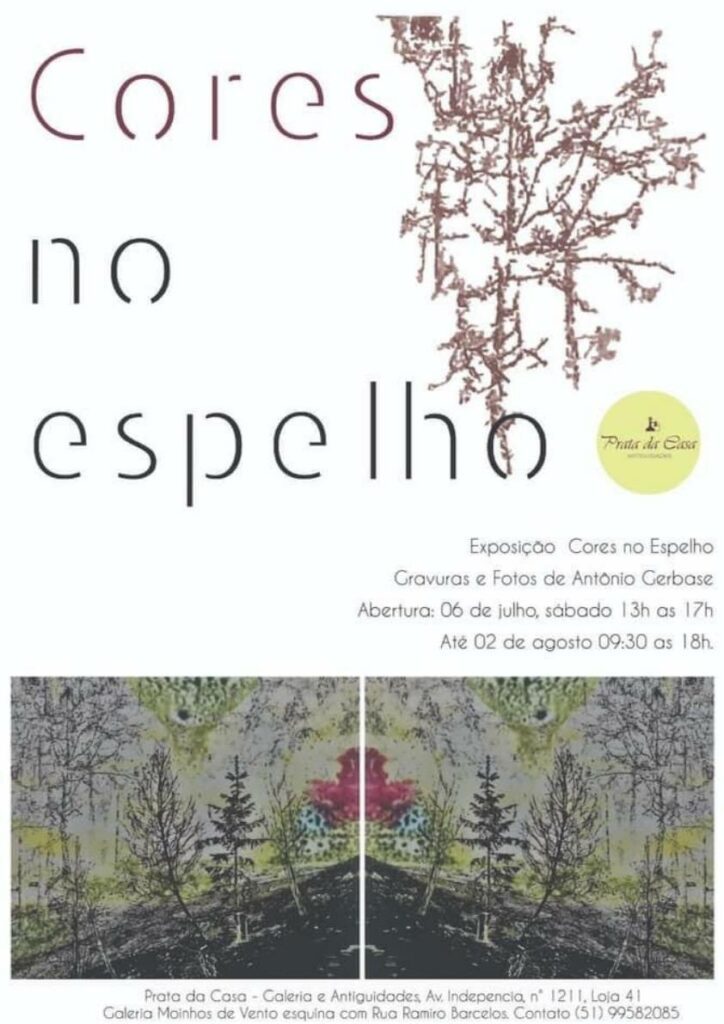

Cores no espelho – aquarelas e gravuras
Galeria Prata da Casa.
Porto Alegre, Brasil, agosto 2019
© 2022 Antonio Gerbase. All rights reserved.